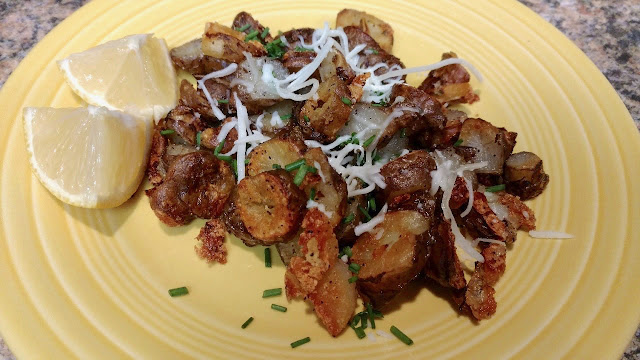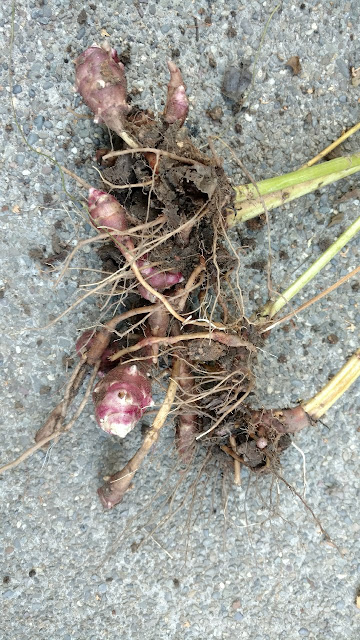
|
Serve the crispy fried sunchokes with cheese, chives and lemon wedges. (Photos: Debbie Arrington)
|
Recipe: Crispy sunchokes make interesting side dish

|
These are freshly dug sunchokes, roots still attached.
|
Were sunchokes part of the first Thanksgiving? It’s very possible. They were cultivated
by native tribes in what we now call New England, long before Pilgrims ever saw Plymouth rock.
And this unusual and Native American vegetable could be part of your fall meals, too.
First, its common name – Jerusalem artichoke – is likely based on miscommunication. A perennial sunflower,
Helianthus tuberosus
has nothing to do with Jerusalem and is only a distant cousin to artichokes (both are in the daisy family).
Tubers from these native sunflowers were boiled and treated pretty much like potatoes (another Native American crop). They were a hit with hungry colonists, who also sent tubers back to Europe.
In 1609, French explorer Samuel de Champlain tasted some in what’s now Cape Cod and proclaimed that the tubers tasted like artichokes. The comparison stuck.
Meanwhile, Italians welcomed this import from the Americas. They called them “girasole (Italian for sunflower) artichokes,” which may have morphed into Jerusalem artichoke.
Another origin story comes from Puritan lore. A group of early colonists called their settlement “New Jerusalem,” where these sunflowers grew wild.
Jerusalem artichokes became popular in Europe and found their way into French and Italian cuisine. Meanwhile, these tubers became an almost forgotten footnote in American cooking.
Enter Frieda Caplan. The Los Angeles produce wholesaler, who died earlier this year at age 96, knew a good veggie when she saw one, but also realized the selling power of a good name. Famously, Frieda gets credit for marketing the Chinese gooseberry as “kiwifruit” and creating a craving for a weird fuzzy fruit.
For several decades, Frieda also crusaded renaming the Jerusalem artichoke as “sunchoke,” emphasizing its sunflower roots.
And “sunflower roots” are what this vegetable is. This perennial sunflower, which easily grows to 10 to 12 feet, forms large tubers after the plant dies back in fall. Those tubers can linger in the ground for many years, sending up new stalks spring after spring.
Once dug up, the tubers last for months in the refrigerator crisper drawer.

|
The sunchokes are scrubbed and ready to parboil.
|
Sunchokes have a mild nutty flavor (yes, similar to artichoke hearts) and lots of natural carbohydrates. That sweetness is in the form of inulin, which does not turn into starch. (This has made sunchokes popular with people on restricted diets.) That inulin content can also lead to a side effect of eating sunchokes: Flatulence.
By parboiling the sunchokes, most of the fart factor is removed.
This recipe and technique, inspired by New York Times food expert Mark Bittman, parboils sunchokes and then fries them until crisp in olive oil. When fried, sunchokes develop a delicious crispy crust – thanks to that natural sweetness.
When parboiling, don’t overcook; the sunchokes will turn mushy.
Crispy sunchokes (Jerusalem artichokes)
Makes 3 to 4 servings
Ingredients:
1 pound sunchokes, well scrubbed
2 to 3 tablespoons extra virgin olive oil
Salt and pepper
Chives (optional)
Parmesan cheese (optional)
Lemon wedges (optional)
Instructions:
With a vegetable brush, scrub sunchokes well, removing any dirt. With a sharp knife, trim off ends.
In a large stainless steel or enameled pot, bring 2 quarts of salted water to a boil. Add sunchokes one at a time, starting with the large ones; add smaller ones about a minute or two after the big ones. Reduce heat to medium and let sunchokes parboil until they’re just tender when poked with a skewer or thin-bladed knife.
Tip: Some will cook faster than others. Remove with a slotted spoon as they become tender.
In a colander, rinse cooked sunchokes with cold water. (If desired, sunchokes can be peeled easily at this point.)
Slice sunchokes crosswise into 1/4-inch slices.
In a heavy and deep frying pan, heat olive oil to medium. Add sunchoke slices and fry, turning often to prevent sticking. Season with salt and pepper as the sunchokes fry. Sunchokes are done when crisp and golden brown, about 15 to 20 minutes.
Remove from pan with a slotted spatula. Drain on paper towels and transfer to plate or serving bowl.
Serve hot with chopped chives, grated Parmesan cheese and lemon wedges.



